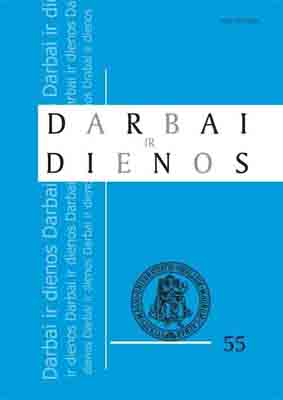Ironijos raiška Kornelijaus Platelio poezijoje
The Expression of Irony in Kornelijus Platelis’s Poetry
Author(s): Gintarė VaitonytėSubject(s): Cultural Essay, Political Essay, Societal Essay
Published by: Vytauto Didžiojo Universitetas
Keywords: ironija; poezija; irony; poetry
Summary/Abstract: Kornelijus Platelis (g. 1951 m.) – šiuolaikinis lietuvių poetas, „kuriantis mitus (jų imitacijas ir drauge – interpretacijas), pasakojantis epines istorijas, kurios persmelktos modernaus žmogaus įžvalgų, naudojantis įvairias antikos, viduramžių ir modernistų ištobulintas technikas ir priverčiantis jas tarnauti naujam turiniui“ (7, 9). Jo kūryboje galima apčiuopti ir suvokti vienokią ar kitokią ironiją. Svarbu suprasti šių dienų autoriaus ironišką požiūrį į gyvenimą, nagrinėti ne tik, iš ko juokiamasi, bet ir kaip tai daroma. Lithuanian poets of the end of the 20th century frequently look at one or another object, the relation between things, and various manifestations of consciousness ironically. For example, Laurynas Katkus depicts in his poetry the ironic relationship between human beings and things, and the ironic perception of the relationship between external and private space. Sigitas Parulskis, another contemporary poet, emphasizes the ironic relationship between the sexes, spirit and corporeality, corporeality and divinity. Irony in the works of Lithuanian poets frequently depicts the tragedy of the human being and conveys a rejection of the possibility of the material world. The irony of Kornelijus Platelis is distinctive, encoded through various images and presenting a double perception of the world. The present article analyzes the ironic part of Kornelijus Platelis’s poetry. The poems are grouped according to the classification of irony in the Encyclopedia of Narrative Theory (2005), published on the basis of the theories of Connop Thirlwall, Dan Sperber and Deirdre Wilson, Linda Hutcheon, Philippe Hamon, Cleanth Brook, Wayne Booth and Ernst Behler; theories which distinguish the following types of irony: 1) irony as verbal strategy, which includes semantic and pragmatic figures of rhetoric; 2) dramatic or situational irony, which shares the rejection of perspicacity and perception alongside with verbal irony; 3) irony as a general attitude towards life and art. An analysis of the collections of poems by Kornelijus Platelis, namely Prakalbos upei (Orations to the River), published in 1995; Atoslūgio juosta (A Belt of the Low Tide), published in 2000; and Palimpsestai (Palimpsests), published in 2004, shows that the number of ironic poems in all these books is the same. Irony as verbal strategy is noticed in Palimpsestai (Palimpsests) and Atoslūgio juosta (A Belt of the Low Tide). Dramatic or situational irony is frequent in Prakalbos upei (Orations to the River) and Atoslūgio juosta (A Belt of the Low Tide). Irony as a general attitude towards life and art is more frequent in Palimpsestai (Palimpsests) and Prakalbos upei (Orations to the River).
Journal: Darbai ir dienos
- Issue Year: 2011
- Issue No: 55
- Page Range: 55-74
- Page Count: 20
- Language: Lithuanian

